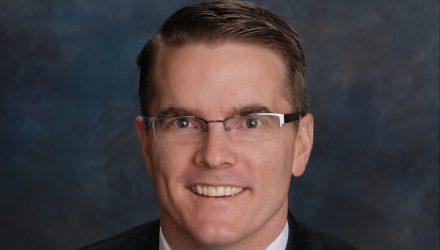On March 30, investment firm Summit Global Investments announced the launch of its debut exchange-traded fund, the SGI Dynamic Tactical ETF (DYTA). The next day, the firm listed its second ETF, the SGI U.S. Large Cap Core ETF (SGLC). Both funds are active, semi-transparent ETFs.
Dave Harden, CEO and CIO of SGI, told VettaFi that, in addition to “providing a good return and good exposure at a prudent level of risk,” the firm launched these ETFs “to show how viable semi-transparent active ETFs can be.”
“I think that this active mutual fund universe is going to move towards semi-transparent active ETFs,” Harden said. “They’re cheaper and accomplish just as much as a mutual fund.”
DYTA: Being in the Right Place at the Right Time
DYTA is a tactical ETF looking for long-term capital appreciation focused on mitigating risk. The fund seeks to participate in rising equity markets, reducing risk when fundamental and quantitative signals identify weakness within various asset classes or sectors. When that happens, SGI will tactically alternate allocations among the underlying securities to seek lower volatility than the S&P 500.
“This is trying to be in the right place at the right time,” he said about DYTA.
Harden explained that one of the reasons why SGI launched DYTA was to accommodate a growing need from clients amid a lack of abundant options.
“There are a few tactical ETFs out there, but I don’t think there’s enough,” Harden said. “Tactical management is a space people are interested in. Instead of trying to keep your long term right, tactical needs to get the next two weeks right.”
Harden explained that while the fund’s portfolio will hold U.S.-based securities of all classes, sizes, and styles, “It does have some boundaries.”
See more: “Summit Global Investments Launches U.S. Large-Cap Core ETF”
SGLC: Avoiding the Boats with Holes
SGLC, meanwhile, is a large-cap core fund designed to help investors achieve market exposure while providing cross-correlation diversification and fundamental downside risk management. The fund’s management team takes a quantitative approach to consider the downside risk of every potential holding. So, if, for example, there are sexual harassment claims or litigation going on in that company, SGLC won’t hold those companies.
“This portfolio is going to have a significant view of what could hurt you. The volatility doesn’t matter, it’s the risk. We’re really big on the ‘G’ part of ESG. Anything that sets off red flags is really important to us. We’ll look at these red flags and avoid them.”
Harden added that SGLC is designed to help investors “go up with the tide” while attempting to “avoid the boats with holes in them.”
SGI launched SGLG because “there’s a missing piece in the puzzle with large-cap core,” Harden said before adding: “Everybody thinks it’s active or index, but no one thinks, ‘Yes, I want that exposure but want to avoid the downside risk.’”
Harden added that SGLC holds its stocks through market downturns, which are likely to be on the horizon.
“We’re going to have some more storms ahead. I don’t think anybody in America is expecting clear skies ahead,” he said. “And yet they want exposure.”
For more news, information, and analysis, visit VettaFi | ETF Trends.
